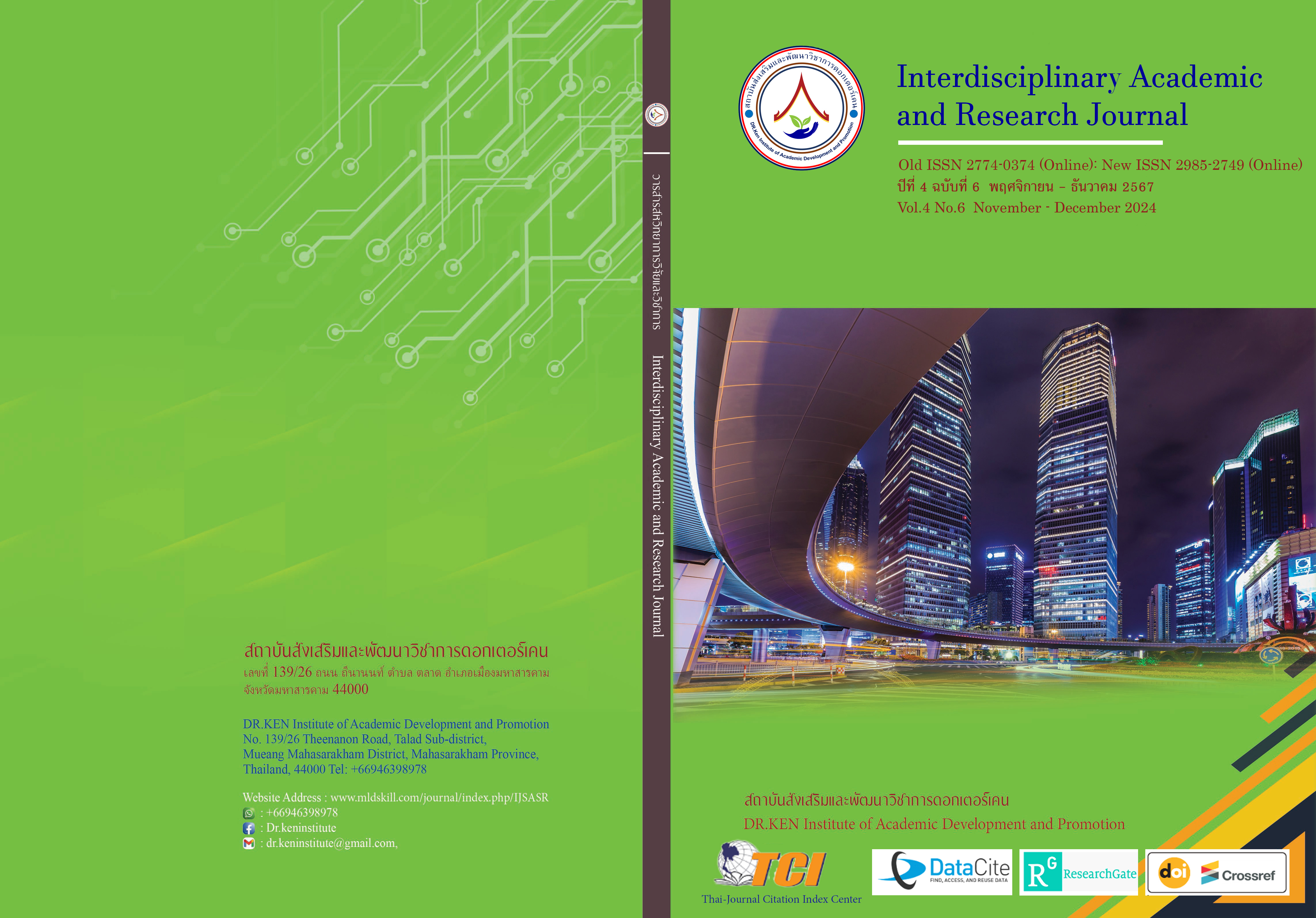Analysis of Investment Returns in Dividend Stocks in the SETHD Index of The Stock Exchange of Thailand, Case Study 2019 - 2023
DOI:
https://doi.org/10.60027/iarj.2024.283065Keywords:
Investment Returns, Dividend Stocks in SETHD, The Stock Exchange of ThailandAbstract
Background and Aims: Investing in the Stock Exchange of Thailand represents a widely embraced strategy for wealth accumulation, as numerous investors seek alternatives that yield superior returns. A particularly favored investment approach involves the acquisition of dividend stocks, which not only facilitate gains through capital appreciation but also generate a consistent flow of dividend income. The aims of this article are 1) to analyze the returns associated with investments in dividend stocks within the SETHD index of the Stock Exchange of Thailand, focusing on a case study spanning the years 2019 to 2023, and 2) to offer recommendations for the selection of dividend stocks within the SETHD index of the Stock Exchange of Thailand.
Methodology: During the entirety of the case study duration, stocks within the SETHD index were selected for evaluation in both the initial and subsequent halves of the year. The analysis revealed the existence of seven corporations that satisfied the specified criteria: AP, KKP, KTB, LH, PTT, TCAP, and TISCO.
Results: Within the scope of the present analysis, two corporations exhibit dividend yields that surpass the mean of the index: LH and TISCO. Two companies demonstrate dividend payout ratios exceeding the average: LH and TISCO. Furthermore, two companies have recorded the highest net profit per share throughout the case study: TCAP and TISCO.
Conclusion: To generate favorable returns, investors must prioritize the following considerations: 1) Dividend yield by selecting equities that offer returns exceeding the benchmark index and exhibit a propensity for sustained growth in returns; 2) Dividend payout ratio by opting for stocks with a payout ratio ranging from 40-60 percent or approximating the mean to secure consistent and favorable returns; and 3) Net profit per share by choosing stocks that demonstrate persistent growth in net profit per share, as this reflects robust business operations, profit potential, and effective cost management.
References
ตลาดหลักทรัพย์แห่งประเทศไทย. (2567) “หุ้นปันผล” อาวุธการลงทุนสุดแกร่งที่นักลงทุนไม่ควรมองข้าม. Retrieved from: https://www.setinvestnow.com/th/knowledge/article/519-invest how-dividend-stock-investment.
อภิสิทธิ์ ม่วงมะเริง. (2565). ผลกระทบของการแพร่ระบาด ของ โรค โค วิด-19 ใน ประเทศไทย ทั้ง 4 ระลอกต่ออัตราผลตอบแทนรวมของ บริษัทในตลาดหลักทรัพย์แห่งประเทศไทย กรณีศึกษา กลุ่มสาธารณูปโภค, กลุ่มสื่อสาร และ กลุ่มวัสดุ. ปริญญาการจัดการมหาบัณฑิต มหาวิทยาลัยมหิดล.
Arsal, M. (2021). Impact of earnings per share and dividend per share on firm value. ATESTASI: Journal Ilmiah Akuntansi, 4(1), 11-18. DOI: https://doi.org/10.33096/atestasi.v4i1.594
Buffett, W. (2009). Warren Buffett on business: Principles from the sage of Omaha. John Wiley & Sons.
Chen, Y., & Israelov, R. (2024). Income illusions: Challenging the high yield stock narrative. Journal of Asset Management, 25(2), 190–202. DOI: https://doi.org/10.1057/s41260-023-00340-1
Cunningham, T. (2024). Portfolio Optimization with Risk Management Through Dividend-Paying Stocks. Master's thesis, St. John's University, New York.
Gordon, M.J. (1959) Dividends, Earnings, and Stock Prices. The Review of Economics and Statistics, 99-105. http://dx.doi.org/10.2307/1927792 DOI: https://doi.org/10.2307/1927792
Graham, B., & McGowan, B. (2003). The intelligent investor. New York: Harper Business Essentials.
Gyeke, M. K., & Kwame, G. (2024). THE IMPACT OF DIVIDEND POLICY ON THE STOCK RETURN VOLATILITY (A STUDY OF FINANCIAL FIRMS LISTED ON THE S&P 500). International Journal of Development Research. 14(2), 64954-64961. DOI:10.37118/ijdr.27847.02.2024
Husna, A., & Satria, I. (2019). Effects of return on asset, debt to asset ratio, current ratio, firm size, and dividend payout ratio on firm value. International Journal of Economics and Financial Issues, 9(5), 50-54. DOI: https://doi.org/10.32479/ijefi.8595
Jorion, P., & Goetzmann, W. N. (1999). Global stock markets in the twentieth century. The journal of finance, 54(3), 953-980. DOI: https://doi.org/10.1111/0022-1082.00133
Kang, E., Kim, R., & Oh, S. (2019). Dividend yields, stock returns, and reputation. ACRN Journal of Finance and Risk Perspectives, 8, 96-100. DOI: https://doi.org/10.35944/jofrp.2019.8.1.006
Kurnia, D. (2022). The Effect of Dividend Per Share, Earning Per Share & Debt to Equity Ratio on Stock Prices with Perceived Risk of Stocks as Moderating Variables. JAK (Jurnal Akuntansi) Kajian Ilmiah Akuntansi, 9(2), 267-280. DOI: https://doi.org/10.30656/jak.v9i2.5108
Markowitz, H. (1952). Modern portfolio theory. Journal of Finance, 7(11), 77-91. DOI: https://doi.org/10.1111/j.1540-6261.1952.tb01525.x
Montier, J. (2009). Value investing: tools and techniques for intelligent investment. John Wiley & Sons.
Nguyen, A. H., Pham, C. D., Doan, N. T., Ta, T. T., Nguyen, H. T., & Truong, T. V. (2021). The effect of dividend payment on firm’s financial performance: An empirical study of Vietnam. Journal of Risk and Financial Management, 14(8), 353-360. DOI: https://doi.org/10.3390/jrfm14080353
Downloads
Published
How to Cite
Issue
Section
License
Copyright (c) 2024 Interdisciplinary Academic and Research Journal

This work is licensed under a Creative Commons Attribution-NonCommercial-NoDerivatives 4.0 International License.
Copyright on any article in the Interdisciplinary Academic and Research Journal is retained by the author(s) under the under the Creative Commons Attribution-NonCommercial-NoDerivatives 4.0 International License. Permission to use text, content, images, etc. of publication. Any user to read, download, copy, distribute, print, search, or link to the full texts of articles, crawl them for indexing, pass them as data to software, or use them for any other lawful purpose. But do not use it for commercial use or with the intent to benefit any business.
















.png)


